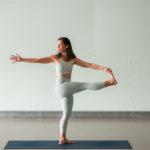Lotus pose, or padmasana, is a traditional meditation posture. It is often photographed and shown as a calm, meditative asana. The Buddha is often depicted in the lotus posture. Lotus pose is one of the most important and useful asanas, especially when practicing pranayama, or breath control.
The benefits of lotus pose are in circulation to the lumbar spine. It tones the abdominal organs, strengthens the legs and ankles, and increases flexibility in the hips. Above all, the lotus pose is a very grounding posture. It is aptly named “lotus” because the lotus flowers root their base in the mud, and the arms and feet resemble the petals of the flower. The seat is the grounding connection to the earth.
Tolasana and/or utthita padmasana is a variation of lotus pose. The posture uses the strength in the core, arms and wrists to elevate the body while keeping the legs in lotus pose.
Although padmasana is considered an archetypal yogic posture, it is not a posture meant for everyone. Contraindications for the posture are hip, knee or ankle injuries. For utthita padmasana, the contraindications list adds wrist and shoulder injuries. In addition, tight hips or thighs make this posture nearly inaccessible.
Many variations exist for tight hips or thighs or arm and core strength. The photograph below shows a variation for arm strength. Using blocks under my hands elevates the floor and makes lifting my seat more accessible.

A variation for padmasana would be half-lotus, where one foot is on the thigh and the other is on the ground. We often have one hip that is more flexible than the other. Starting with half-lotus protects against injury of the knee and ankle. Albeit, elevated half-lotus can seem more difficult as you have to also lift the lower leg into the body because it is not tucked into the thigh.
You may choose to omit lotus, or half-lotus, and sit on top of the heels. By placing the blocks under the arms, both legs may be elevated from this position, and the same core and arm strength is used. This version is the most accessible to all ranges in flexibility.
Keep in mind that your very unique body, with all its stories, is special. For some, lotus pose is easy. For others (myself included), it takes a significant amount of warm-up to achieve. For others, it is a posture that may take years of practice to attain. And for some, it is a posture that will never be a part of their practice. Wherever you are in your unique yoga practice, let this be a posture you come to with grace. Honor your body and listen for signals of when to stop. Regardless of which variation you attempt, do so with an underlying quality of compassion for yourself and for your special body.
- After warming up the body, sit with your legs extended.
- Bend the right knee and place the foot over the left thigh so that the right heel is near the naval.
- Bend the left knee and place it over the right thigh with the heel also near the naval.
- Place both hands on the floor in line with the mid-thigh.
- As you exhale, press the hands and lift the body off the floor.
- Stay for five breaths and return to lotus pose.
- Breathe for 10 breaths in padmasana.
Namaste.


